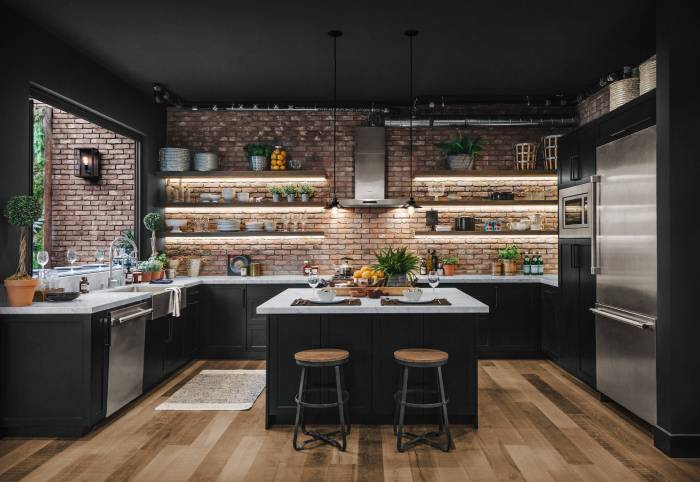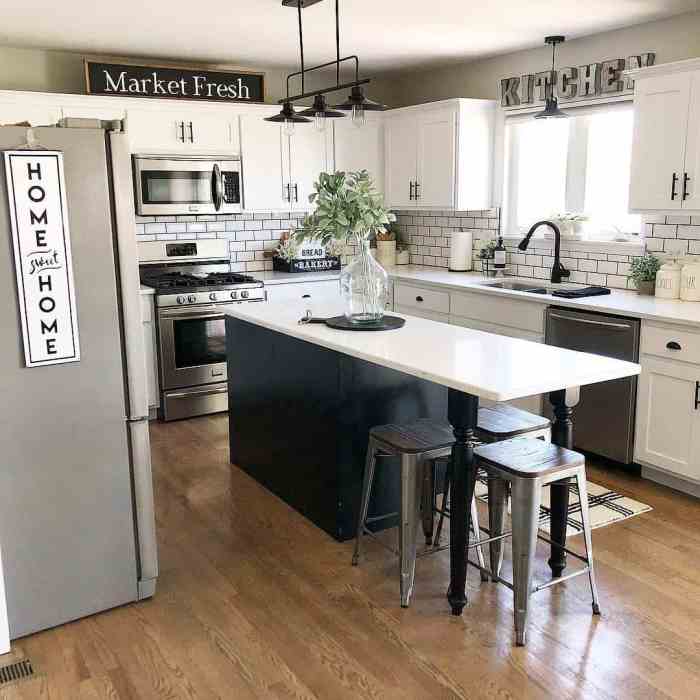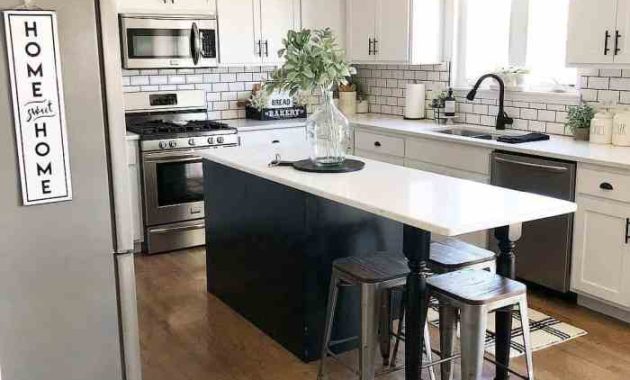Black and White Kitchen Design Styles
Decor for black and white kitchen – The enduring appeal of black and white kitchens lies in their versatility. This classic color combination can be adapted to suit a wide range of design aesthetics, from sleek and modern to rustic and charming. The interplay of light and shadow, the crisp contrast, and the inherent elegance make it a popular choice for homeowners seeking a timeless yet stylish kitchen space.
This section will explore three distinct black and white kitchen design styles, highlighting their key features, color palette variations, and material choices.
Black and White Kitchen Design Styles: A Comparative Analysis, Decor for black and white kitchen
The following table compares three distinct black and white kitchen design styles, examining their defining characteristics and material preferences. Understanding these differences allows for a more informed design process, ensuring the final aesthetic aligns with the homeowner’s desired style and functionality.
| Style Name | Key Features | Color Palette Variations | Example Materials |
|---|---|---|---|
| Modern Minimalist | Clean lines, simple shapes, lack of ornamentation, open shelving, integrated appliances, focus on functionality. | Predominantly black and white with minimal use of accent colors (e.g., a single bold color for bar stools or backsplash). High contrast is key. | High-gloss lacquered cabinetry, stainless steel appliances, concrete or polished concrete floors, quartz or Caesarstone countertops, sleek metal hardware. |
| Farmhouse Chic | Rustic elements, vintage-inspired details, exposed wood beams or shelving, natural textures, a sense of warmth and casual elegance. | Black and white with the addition of natural wood tones (light oak, walnut), creamy whites, and subtle grey accents. The contrast is softer than in the minimalist style. | White shaker-style cabinetry, butcher block countertops, reclaimed wood flooring, open shelving, farmhouse sink, black metal hardware, patterned backsplash tiles (black and white). |
| Traditional | Classic details, ornate molding, detailed cabinetry, often features dark wood accents, formal and elegant aesthetic. | Black and white with deeper black tones and creamy off-whites. May incorporate subtle metallic accents like gold or brass. | Dark stained wood cabinetry (black or dark brown), marble or granite countertops, patterned ceramic or porcelain floor tiles, brass or nickel hardware, possibly a decorative backsplash with intricate patterns. |
Lighting’s Impact on Black and White Kitchen Design Styles
Lighting plays a crucial role in enhancing the aesthetic appeal and functionality of a black and white kitchen. The strategic placement and type of lighting can dramatically alter the perception of space, highlight key features, and create a desired mood. For instance, in a modern minimalist kitchen, recessed lighting provides even illumination, emphasizing the clean lines and simplicity.
In contrast, a farmhouse chic kitchen might benefit from a combination of pendant lights over an island, recessed lighting, and under-cabinet lighting to highlight textures and create a warm ambiance. Traditional kitchens often incorporate chandeliers or statement pendant lights to add a touch of grandeur and elegance, complemented by wall sconces for task lighting. In each style, layered lighting is key to avoid harsh shadows and ensure adequate illumination for food preparation and dining.
Countertop Material Selection and Aesthetic Impact
The choice of countertop material significantly impacts the overall aesthetic of a black and white kitchen. Marble, with its inherent veining and luxurious feel, complements traditional and even some farmhouse styles, adding a touch of sophistication. However, its susceptibility to staining and etching necessitates careful consideration. Quartz, a durable and low-maintenance option, offers a more modern and clean look, suitable for minimalist and contemporary kitchens.
Its versatility allows for a range of colors and patterns, including those that mimic the look of marble without the drawbacks. Butcher block countertops, with their warm, natural wood grain, bring a rustic charm to farmhouse chic kitchens, adding texture and a touch of casual elegance. The choice should be aligned with the overall design style and the homeowner’s lifestyle and maintenance preferences.
Flooring Options and Considerations: Decor For Black And White Kitchen

The selection of flooring for a black and white kitchen is crucial, as it significantly impacts both the aesthetic and the functionality of the space. The chosen material must be durable enough to withstand daily wear and tear, relatively easy to maintain, and aesthetically complement the bold color scheme. Furthermore, the flooring’s texture and pattern can subtly (or dramatically) alter the overall feel of the room, from modern and sleek to classic and timeless.The following Artikels three suitable flooring options for a black and white kitchen, considering their durability, maintenance, and aesthetic contribution.
Suitable Flooring Materials for Black and White Kitchens
- Porcelain Tile: Porcelain tile offers exceptional durability, resisting scratches, stains, and moisture. Its low maintenance requirements make it ideal for high-traffic areas like kitchens. Aesthetically, porcelain tile can mimic the look of other materials, such as natural stone or wood, while offering superior practicality. In a black and white kitchen, large format porcelain tiles in either color would create a striking, modern look.
Smaller, patterned tiles could add a touch of vintage charm. The non-porous nature of porcelain makes cleaning a breeze; a simple sweep and mop is usually sufficient.
- Engineered Wood: Engineered wood flooring provides a warmer, more natural feel than tile, while still offering good durability. It’s less susceptible to moisture damage than solid hardwood, making it a relatively safe choice for kitchens, although care should still be taken around spills. Engineered wood comes in a wide variety of colors and finishes, allowing for a range of aesthetic choices.
A light-colored engineered wood floor could create a bright and airy feel, contrasting beautifully with black cabinetry and countertops. Darker engineered wood could add a touch of drama and sophistication.
- Luxury Vinyl Plank (LVP): LVP is a cost-effective option that mimics the look of higher-end materials like hardwood or stone. It’s highly durable and waterproof, making it an excellent choice for kitchens prone to spills and moisture. LVP is also relatively easy to install and maintain. In a black and white kitchen, LVP can provide a clean, contemporary aesthetic, particularly in a large-format plank design.
Black and white kitchens offer a timeless elegance, but require careful consideration of wall decor to avoid a stark feel. Finding the right balance is key, and inspiration can be drawn from the latest trends; for example, check out the kitchen wall decor ideas 2024 for fresh perspectives. This will help you select pieces that complement the monochrome palette and inject personality into your space, whether it’s bold artwork or subtly textured materials.
A high-gloss finish can add a touch of glamour, while a matte finish creates a more understated look.
Influence of Flooring Material on Kitchen Ambiance
The choice of flooring material significantly impacts the overall feel of a black and white kitchen. For instance, cold, hard surfaces like porcelain tile can create a modern, minimalist atmosphere, particularly when paired with sleek cabinetry and stainless steel appliances. In contrast, the warmth and texture of engineered wood flooring can soften the starkness of the black and white palette, lending a more traditional or rustic feel, depending on the wood’s finish and pattern.
Luxury vinyl plank, depending on its design, can adapt to various styles, from modern to rustic, depending on the chosen pattern and finish. A large-format, wood-look LVP might create a warmer, more inviting space than a smaller, tile-look LVP.
Color and Pattern Considerations in Relation to Kitchen Design
The color and pattern of the flooring should be carefully considered in relation to the rest of the kitchen’s design. A monochromatic scheme, using only black and white in the flooring, can create a dramatic and visually striking effect. However, this approach might feel too stark for some. Introducing a third color, such as gray, can soften the contrast and add visual interest.
Patterned flooring can also add texture and personality to the space. For example, a black and white checkered floor can create a classic and timeless feel, while a geometric pattern can introduce a more contemporary touch. The flooring’s color and pattern should complement, not compete with, the other design elements in the kitchen, such as the cabinetry, countertops, and backsplash.
For example, a busy patterned floor might clash with equally busy countertops, creating a visually overwhelming space. A simple, neutral floor would provide a better balance.
Incorporating Accessories and Decor

A black and white kitchen, while striking in its simplicity, benefits greatly from carefully chosen accessories and decor to prevent it from feeling stark or cold. The key is to introduce elements that add warmth, texture, and visual interest without disrupting the overall monochrome palette. Strategic placement of carefully selected items can transform the space from a minimalist design into a sophisticated and inviting culinary haven.
Adding decorative accessories and natural elements is crucial for achieving a balanced and visually appealing black and white kitchen. These additions provide warmth, texture, and personality, preventing the space from feeling overly sterile. Careful consideration of materials, colors, and styles ensures a cohesive and elegant design.
Five Decorative Accessories for a Black and White Kitchen
The following five accessories offer diverse ways to enhance a black and white kitchen’s aesthetic, introducing pops of color or texture without overwhelming the existing scheme.
- Statement Lighting: A dramatic pendant light fixture in brushed nickel or polished chrome can serve as a focal point, reflecting light and adding a touch of modern elegance. Consider a design with geometric shapes or interesting textures to complement the clean lines of the kitchen. For example, a large, globe-shaped pendant light in brushed nickel would offer a soft, diffused light while adding a sophisticated industrial touch.
- Textured Bar Stools: If the kitchen features a breakfast bar or island, consider bar stools with woven seats or a leather-like finish. The texture adds visual interest and a touch of comfort, contrasting beautifully against the sleek surfaces of the black and white cabinetry. For instance, stools with a woven rattan seat would introduce natural texture and warmth.
- Metallic Accents: Incorporating metallic accents such as copper or brass through hardware, decorative bowls, or canisters introduces subtle warmth and visual interest. These metallic finishes add a touch of luxury and can beautifully complement both black and white elements. A set of copper mixing bowls displayed on an open shelf would provide both functionality and visual appeal.
- Black and White Artwork: Abstract black and white art or photography adds visual depth and personality without introducing color. Choose pieces with varying textures or brushstrokes to create visual interest. For example, a large-scale black and white photograph of a city skyline could create a dramatic focal point.
- Wooden Cutting Board: A large, high-quality wooden cutting board displayed on the counter not only serves a practical purpose but also introduces a natural element and warm texture. Opt for a rich, dark wood to create a striking contrast against the white countertops and cabinetry. A thick, acacia wood cutting board would add a rustic, yet sophisticated touch.
Incorporating Plants and Natural Elements
Plants and natural elements are invaluable in softening the stark contrast of a black and white kitchen, adding warmth and a sense of life. Their textures and colors create a visually appealing contrast and balance.
Strategic placement of potted plants, such as snake plants, ZZ plants, or peace lilies (known for their tolerance of low light conditions often found in kitchens), can add visual interest and improve air quality. A small herb garden in a windowsill provides both aesthetic appeal and functional benefits. Natural materials like wood and stone in accessories further enhance this effect.
For example, a small bamboo plant in a sleek black pot would add a touch of green without overwhelming the color scheme.
A Simple and Elegant Centerpiece
A simple yet elegant centerpiece for a black and white kitchen table should complement the existing design without being overly fussy. The focus should be on clean lines and interesting textures.
A centerpiece featuring a low, rectangular white ceramic bowl filled with black and white pebbles or river stones would create a visually appealing and texturally interesting focal point. The bowl could be placed on a simple black or white placemat. Alternatively, a single, elegant white orchid in a simple black pot would add a touch of sophistication and natural beauty.
The overall style should maintain the clean lines and minimalist aesthetic of the kitchen, adding a subtle touch of visual interest without overwhelming the space.
Query Resolution
What are some budget-friendly ways to incorporate black and white decor?
Affordable options include painting existing cabinets, using inexpensive subway tile for a backsplash, and adding affordable black and white accessories like canisters and dish towels.
How can I avoid a stark or cold feeling in a black and white kitchen?
Incorporate warm metallic accents (gold, copper), natural textures (wood, plants), and soft lighting to counterbalance the starkness of black and white.
What size tiles are best for a black and white kitchen backsplash?
Subway tiles (3×6 inches) are popular, but larger format tiles can create a more modern look, while smaller mosaics add visual interest.
Can I mix different styles within a black and white kitchen?
Absolutely! A black and white palette is versatile enough to support a blend of styles. For example, you could combine modern cabinets with farmhouse-style lighting and traditional hardware.

